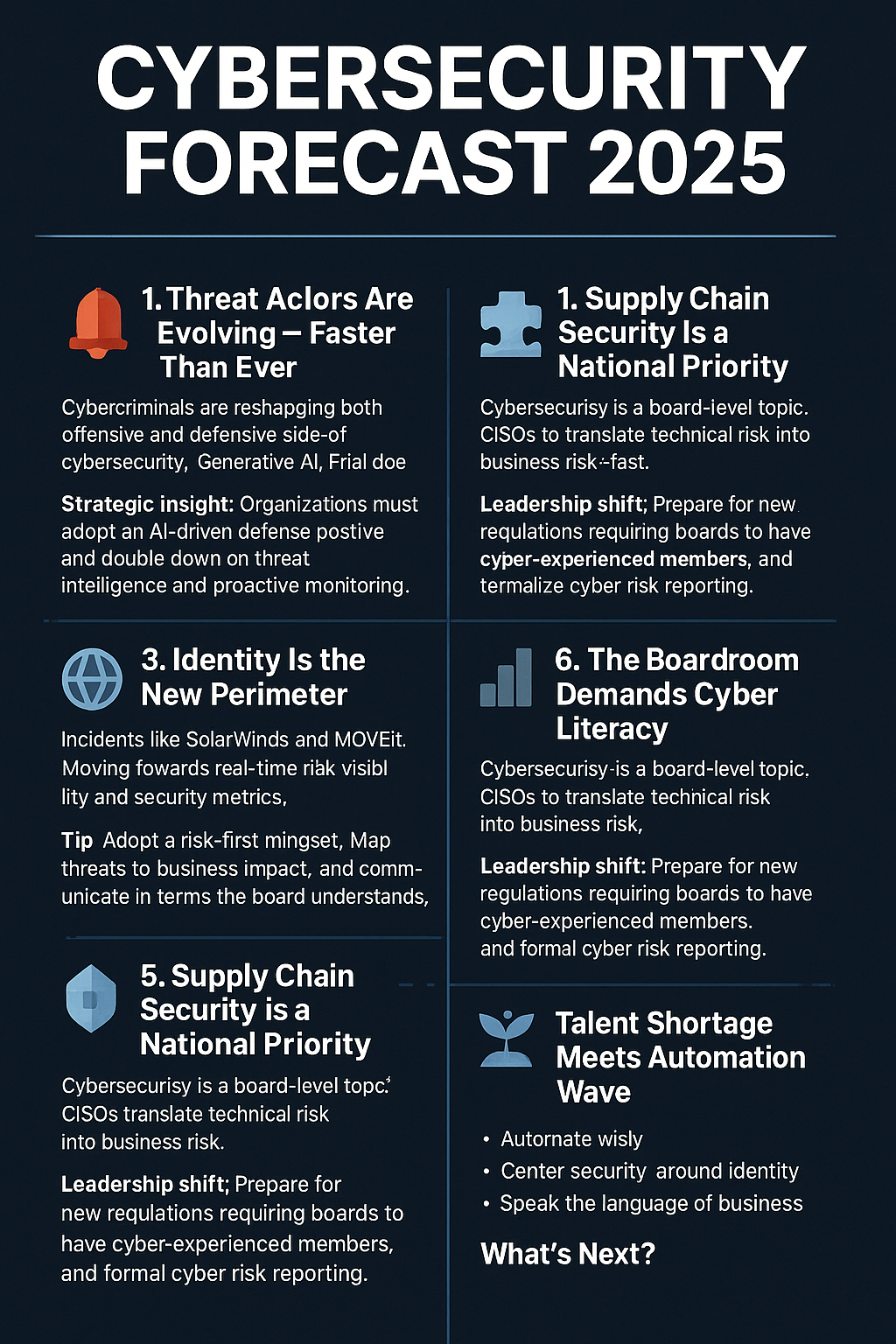Cybersecurity Mid-Year Forecast 2025: Key Trends and Strategic Insights
- 4 minutes read - 686 wordsAs we navigate through 2025, the cybersecurity landscape continues to evolve at a blistering pace—fueled by rapid advances in artificial intelligence, increasingly aggressive threat actors, and a shifting regulatory environment. Traditional playbooks are being rewritten, and defenders must rethink not just their tools, but their strategies, mindsets, and organizational alignment.
The Cybersecurity Forecast 2025, powered by insights from Google Cloud and Mandiant experts, offers a timely and deeply informed look into the key trends shaping this new era of security. From the weaponization of generative AI to the rise of identity-based attacks and the growing complexity of cloud-native threats, this report outlines where the industry is headed—and what we must do to stay ahead.
In this post, we break down the most critical takeaways and translate them into practical, strategic insights that cybersecurity professionals, technical teams, and business leaders alike can use to future-proof their security posture.

I used AI to create this, bare with me, and excuse the typos!
🚨 1. Threat Actors Are Evolving – Faster Than Ever
The report highlights a stark reality: cybercriminals are innovating as fast—or faster—than defenders. From leveraging AI to generate sophisticated phishing attacks to exploiting misconfigured cloud services, attackers are blending automation with deception.
Key takeaway: Organizations must adopt an AI-driven defense posture and double down on threat intelligence and proactive monitoring.
🧠 2. Generative AI: Friend and Foe
Generative AI is reshaping both the offensive and defensive sides of cybersecurity:
- Attackers use LLMs to automate social engineering, write malware, and evade detection.
- Defenders are deploying AI for log analysis, anomaly detection, and phishing prevention.
Strategic insight: Expect a surge in AI governance, especially around model integrity, prompt injection risks, and insider threats related to data leakage.
🌐 3. Identity Is the New Perimeter
With the cloud-first shift and hybrid work here to stay, identity and access management (IAM) has taken center stage.
- Zero Trust is no longer optional—it’s a baseline.
- MFA fatigue and push bombing attacks are forcing orgs to rethink authentication strategies.
Key moves: Invest in phishing-resistant MFA, continuous authentication, and identity behavior analytics.
🛡️ 4. From Compliance to Continuous Risk Management
Compliance checkboxes aren’t cutting it anymore. The report urges a move toward real-time risk visibility and business-aligned security metrics.
Tip: Adopt a risk-first mindset. Map threats to business impact, and communicate in terms the board understands.
🧩 5. Supply Chain Security Is a National Priority
Supply chain attacks are top-of-mind following incidents like SolarWinds and MOVEit. Governments are now mandating software bills of materials (SBOMs) and increasing scrutiny on third-party risk.
Action item: Formalize your vendor security assessment process and align with NIST’s Secure Software Development Framework.
📊 6. The Boardroom Demands Cyber Literacy
Cybersecurity is now a board-level topic. Executives expect actionable insights, not jargon. CISOs must translate technical risk into business risk—fast.
Leadership shift: Prepare for new regulations requiring boards to have cyber-experienced members, and formal cyber risk reporting.
🌱 7. Talent Shortage Meets Automation Wave
While the skills gap persists, automation is reducing the burden on stretched teams. Security teams are increasingly leaning on:
- SOAR platforms
- LLMs for policy generation
- Automated playbooks
Recommendation: Upskill your team to focus on creative problem-solving, threat modeling, and strategy, not just tool operation.
🔮 What’s Next?
2025 is shaping up to be a defining year for cybersecurity maturity. Organizations that thrive will be those who:
- Automate wisely
- Center security around identity
- Speak the language of business
- Build resilient, adaptive security cultures
Cybersecurity is no longer a technical problem—it’s a strategic one. And in 2025, strategy beats speed.
📚 Further Reading & Resources
- Cybersecurity Forecast 2025 – Google Cloud
- AI-driven Cybersecurity: Key Takeaways from Google Cloud’s 2025 Forecast
- NIST Releases First 3 Finalized Post-Quantum Encryption Standards
- Preventing Large-Scale Crypto Hacks: Key Security Measures for Exchanges
- Microsoft Security in Action: Deploying and Maximizing Advanced Identity Protection
🧠 Want to dive deeper? Check out our Resources page.
Thanks for reading,
Michael
If you enjoy the content, then consider buying me a coffee.
P.S. Stay updated on the latest cybersecurity trends and best practices by subscribing to our newsletter or leaving your thoughts in the comments below! Visit CyberSHIELD